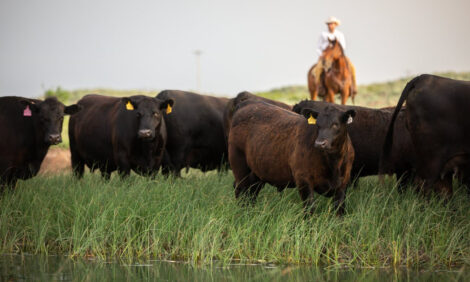



Animal Health Considerations for Cows Fed in Confinement
When placing cows in confinement typical vaccination programmes should include IBR, BVD, Lepto hardjo-bovis and Lepto pomona, and Campylobacter(Vibrio)fetus, advises Larry Hollis, Extension Beef Veterinarian at Kansas State University.Larry Hollis writes: How cows are managed in preparation for drylot feeding will affect the success of this necessity. If producers are going to drylot their own cows and feed them home?raised or purchased forages,the situation is fairly simple from a health standpoint.
Just make certain they are current on the respiratory and reproductive disease vaccination programme currently in use prior to placing them in a confined drylot situation.
IBR and BVD vaccinations serve to protect against both respiratory and reproductive disease losses. Adult cattle are rarely affected by PI3 or BRSV,so these components do not have to be added except in replacement heifers that are retained. A typical minimum program would include vaccination against IBR, BVD, Lepto hardjo-bovis and Lepto pomona, and Campylobacter (Vibrio) fetus.
If calf hood vaccination for Brucellosis (Bangs) is part of your routine heifer development program,this vaccine should be administered by your veterinarian before heifers reach 12 months of age (prior to 10 months of age is preferable). If dusty conditions are anticipated while cows are being drylotted,the addition of Mannheimia haemolytica leukotoxoid and Pasteurellamultocida bacterin to the vaccine program should also help cut down on pneumonia problems in these adult animals.
Deworm the animals prior to placing them into the drylot. Being worm free will greatly improve their feed efficiency. Feed animals from bunkers and above?ground water tanks to keep animals from eating and drinking from the ground, reducing the potential for spread of disease.
Mr Hollis adds, make sure adequate clean water is freely available, and feed to maintain appropriate body condition score (BCS) for the stage of production the females are in. The animals’ requirements will change as they progress through the seasons and stages of production, so the diet will need to change also.
A second option would be to place your cows into a commercial feedlot. The feedlot’s consulting nutritionist should be able to develop a ration that is both economical and sufficient to meet your animals’ needs as they progress through the different production stages. Because of the possibility of being placed in feedlot pens adjacent to commingled feeder animals from multiple out?of?state origins, it is imperative that cows and heifers be vaccinated 2?3 weeks in advance of when they are to be placed in the feedlot.
Plan to use the whole array of vaccinations mentioned above, and have all vaccinations completed before moving cows to the feedlot. This will give your cows time to respond fully to the vaccines and maximize their immune response at the time of initial exposure. You may want to add a SRP Salmonella vaccine for control of Salmonellosis if feedlot history indicates that this disease has been a problem.
If possible, have the feedlot place your cows in the same section as other cows that they may be feeding for other ranchers. You may want to ask that any of your cattle that require treatment be treated and returned immediately to the home pen, rather than being left in the hospital pen where
they might be commingled with sick cattle from a variety of other pens.
Most feedlots process all incoming cattle with modified live virus (MLV) IBR, BVD, PI3 and BRSV vaccines. Do not let them do this to your pregnant animals unless your animals have been previously vaccinated with MLV vaccines as use of MLV vaccines in naïve unvaccinated animals, or those that have only been vaccinated with killed IBR and BVD vaccines in the past,may cause them to abort if they receive their initial dose of MLV vaccine while already pregnant.
With these precautions in mind, it is possible to drylot cows successfully. Whether you do this in your own facilities or a commercial feedlot, drylotting will provide a way to keep a good set of cows together for when it finally starts raining and we have grazeable grass again!


